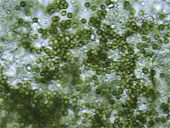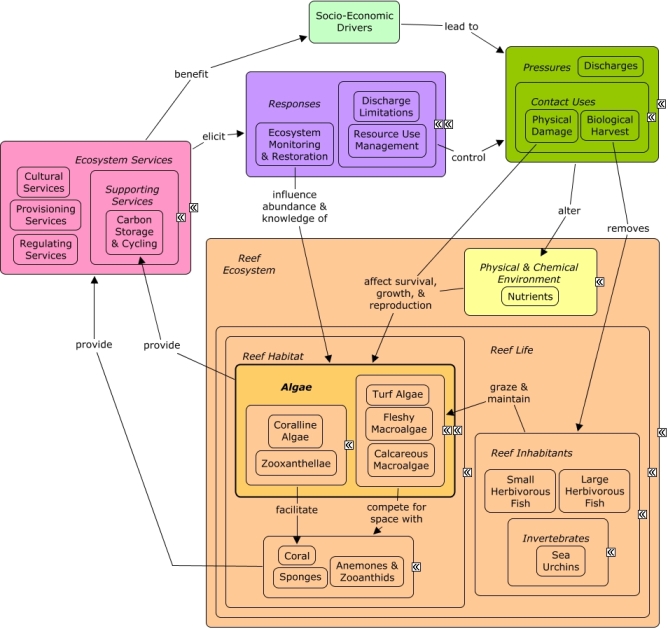ReefLink Database

Zooxanthellae
Zooxanthellae are flagellate protozoa that are golden-brown intracellular endosymbionts of various marine animals and protozoa, especially anthozoans such as the scleractinian corals
CMap

CMap Description
Zooxanthellae, a type of algae, form symbiotic relationships with various marine animals. In coral, zooxanthellae, provide carbon storage & cycling via photosynthesis, supplying up to 90% of the hosts energy requirements and facilitating growth and development of the reef. Zooxanthellae also act as the pigment for the multitude of distinct coral colors. Pressures, caused by socio-economic drivers, modify the physical & chemical environment by increasing sea surface temperatures, increasing sediment loads, varying salinity, or introducing disease causing microorganisms onto the reef. Under these conditions coral will "bleach," breaking the symbiotic relationship by expelling or digesting the zooxanthellae. Ultimately, the coral dies if it is unable to regain zooxanthellae. Monitoring, mapping, and scientific research can be used to track the distribution and abundance of bleaching, and to understand environmental stresses leading to coral bleaching.Citations
More than 50 citations. Click here to load.
| Citation | Year | Study Location | Study Type | Database Topics |
|---|
Management Options
| Management Option | Description | Sources | Database Topics |
|---|---|---|---|
| Restoration: Removal of Invasive Algae | Benthic organisms on reefs maintain a delicate balance competing for space. In many areas, the competition between coral and algae has fallen out of balance due to confounding factors. Factors such as decreased herbivorous fish and invertebrates, and invasive algae species have allowed faster growing algae to take over many reefs, often growing into smothering mats that cover and kill coral. In Hawaii, there has been some success physically removing invasive algae such as Kappaphycus using underwater vacuums extended down from barges or volunteer events in shallower areas. | The Nature Conservancy. 2010.Two Million Pounds of Invasive Algae Removed From Maunalua Bay. (not cited) |
Algae; Aquaculture; Biological Addition; Biological Harvest; Biological Monitoring & Restoration; Biological Monitoring, Mapping, & Scientific Research; Calcareous Macroalgae; Collaboration & Partnering; Coral; Coralline Algae; Decision Support; Ecosystem Monitoring & Restoration; Escape & Release of Non-natives; Fishing & Harvesting Management; Fishing Sector; Fleshy Macroalgae; Hydrocoral; Invasive Species; Large Herbivorous Fish; Octocoral; Reef Habitat; Skeletal Coral; Small Herbivorous Fish; Stony Coral; Turf Algae; Wetland & Reef Restoration; Zooxanthellae |
Laws
| Legal Citation | Purpose of Law | Management Organization | Database Topics |
|---|
